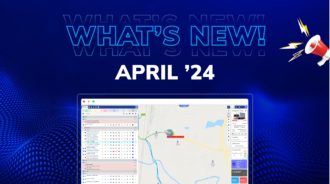In the fast-paced world of logistics and transportation, ensuring the safety and efficiency of your fleet is paramount. Driver fatigue, a critical concern in the industry, significantly increases the risk of accidents and decreases productivity. With the advent of advanced technology, particularly in fleet management software, there are now more innovative strategies than ever to combat this pervasive issue. In this comprehensive guide, we will delve into the world of driver fatigue monitoring. We will explore the latest trends and how they integrate with advanced fleet management systems to keep drivers alert and fleets running smoothly.
Understanding Driver Fatigue: A Persistent Challenge
Understanding driver fatigue is crucial for multiple reasons, primarily revolving around safety, efficiency, and compliance. Here’s a detailed look into what driver fatigue is, why it’s important to understand it, and the implications it has on individuals and the broader transportation industry.
What is Driver Fatigue?
Driver fatigue refers to a state of exhaustion or decreased ability to perform safely on the road due to lack of sleep, extended periods of driving, or the body’s natural low-energy periods. It’s not just feeling sleepy; it’s a significant decline in mental and physical performance. Symptoms can include slower reaction times, decreased vigilance, and impaired decision-making. Critical signs of driver fatigue include:
- Frequent yawning and blinking: An unconscious effort to keep oneself awake.
- Drifting from lanes: A sign of decreased concentration and control.
- Microsleeps: Brief, uncontrollable episodes of sleep that can last from a fraction of a second up to 30 seconds.
- Difficulty focusing: Inability to keep a steady gaze or maintain consistent speed.
Why Understanding Driver Fatigue is Important
- Safety: This is the most critical reason. Fatigued driving can be just as dangerous as drunk driving. A fatigued driver’s reaction time, ability to assess situations quickly, and make informed decisions are all impaired, increasing the risk of accidents significantly.
- Efficiency and Productivity: Fatigue leads to decreased performance. For commercial drivers, this means less efficient operations, as fatigued drivers are slower, take longer routes, or require more frequent breaks, all of which contribute to decreased productivity.
- Health of Drivers: Chronic fatigue can have severe long-term health effects on drivers, including cardiovascular disease, gastrointestinal problems, and severe mental health issues. Understanding and managing driver fatigue is crucial for the long-term health and well-being of drivers.
- Economic Implications: Accidents caused by driver fatigue can lead to substantial economic costs, including medical bills, vehicle repairs, insurance claims, and lost productivity. For companies, this can also mean legal liabilities and increased insurance premiums.
- Regulatory Compliance: Many countries have regulations about driving hours, rest periods, and logging hours. Understanding driver fatigue is essential for compliance with these laws to avoid penalties and ensure operations are legal and safe.
Implications of Not Understanding Driver Fatigue
Ignoring the signs and effects of driver fatigue can lead to dire consequences. These can range from minor fender benders to severe, fatal accidents. Beyond the immediate physical dangers, there are also significant legal and financial repercussions for both the driver and the company they work for. Companies that don’t prioritize understanding and mitigating driver fatigue risk losing their reputation, facing legal issues, and incurring high costs.
Understanding driver fatigue is not just about recognizing when a driver is sleepy; it’s about comprehending the full spectrum of how fatigue affects performance, safety, and health. It’s about creating a culture within the transportation industry that prioritizes rest, recognizes the signs of fatigue, and takes proactive steps to combat it. By doing so, companies can ensure the safety of their drivers and others on the road, improve their operational efficiency, and contribute to a more responsible and sustainable industry.
The Trends in Fleet Management: Embracing Technology
The landscape of fleet management is constantly shifting, with new technologies emerging to address a range of challenges, including driver fatigue. Solutions like Trakzee are at the forefront, offering a suite of tools designed to monitor, analyze, and improve driver behavior and safety. By staying abreast of these trends, fleet managers can leverage technology to enhance operational efficiency and safety.
Driver Fatigue Monitoring: A Key Trend
One of the most impactful trends is the focus on driver wellbeing, particularly through driver fatigue monitoring. Here’s how it’s proving to be useful:
- Enhanced Safety: The primary benefit is the significant reduction in accidents. By identifying signs of fatigue early, systems can alert drivers to take a break, preventing potential accidents caused by drowsiness.
- Improved Compliance: Regulations often limit the number of hours a driver can be on the road. Fatigue monitoring helps ensure compliance with these regulations by providing accurate, real-time data on driver status.
- Data-Driven Insights: Fatigue monitoring systems collect data that can be analyzed to identify patterns and make informed decisions. For example, if a particular route consistently leads to driver fatigue, it might be due to traffic, poor road conditions, or other stressors that need to be addressed.
- Enhanced Driver Health and Morale: Regularly driving while fatigued can have severe long-term health effects. By monitoring and managing fatigue, companies show they value their drivers’ health and wellbeing, which can improve morale and reduce turnover.
- Cost Savings: Fewer accidents mean lower costs related to insurance, vehicle repairs, and potential litigation. Additionally, healthier drivers are more productive and take fewer sick days, contributing to more efficient operations.
The trend of embracing technology in fleet management, particularly through driver fatigue monitoring, is not just a passing phase but a significant shift towards safer, more efficient, and more responsible operations. As technology continues to evolve, we can expect even more innovative solutions to emerge, further transforming the landscape of fleet management. Companies that recognize and adapt to these trends will be well-positioned to thrive in this new era.
Trakzee: Your Partner in Combatting Driver Fatigue
Trakzee isn’t just a tool; it’s a comprehensive fleet management solution designed with safety and efficiency in mind. Its features are tailored to identify signs of driver fatigue early and take proactive measures. Real-time monitoring, alert systems, and detailed reports are just the tip of the iceberg when it comes to how Trakzee can transform your approach to managing driver fatigue.
Innovative Strategies to Combat Driver Fatigue
Real-Time Monitoring and Alerts
- Trakzee’s real-time monitoring system keeps a vigilant eye on driver behavior and vehicle performance. By setting up alerts for signs of fatigue, such as erratic driving or prolonged periods without a break, fleet managers can intervene before it’s too late.
Data-Driven Insights
- Utilize Trakzee’s analytics to understand patterns in driver behavior and identify potential risk factors. This data is invaluable for tailoring training programs and implementing targeted strategies to reduce fatigue.
Enhanced Communication
- Effective communication channels between drivers and fleet managers are crucial. Trakzee facilitates this with features that allow for instant messaging and alerts, ensuring that drivers can report fatigue symptoms and receive assistance promptly.
Scheduled Rest Breaks
- Trakzee’s scheduling tools help ensure drivers take adequate rest breaks. By analyzing routes and schedules, the software can recommend optimal times and locations for breaks, helping drivers stay refreshed and alert.
Educational Programs
- Use Trakzee’s resources to educate your drivers about the risks of fatigue and the importance of proper rest. Knowledge is a powerful tool in combating fatigue and promoting a culture of safety.
Implementing a Culture of Safety
Adopting technology like Trakzee is just one part of the equation. Creating a culture that prioritizes safety involves ongoing education, open communication, and a commitment from all levels of the organization. Encourage drivers to speak up about fatigue, provide feedback on the tools and strategies in place, and continuously refine their approach based on real-world experiences.
Conclusion
Beating driver fatigue is an ongoing battle, but with innovative strategies and the power of advanced fleet management software like Trakzee. It’s a fight that can be won. By leveraging the latest trends in technology, fostering a culture of safety, and continually seeking out ways to improve, fleet managers can ensure their drivers stay alert, safe, and efficient on the roads. Remember, combating driver fatigue isn’t just about compliance and safety; it’s about protecting lives and enhancing the overall well-being of your drivers. With Trakzee by your side, you’re equipped to beat the blink and keep fatigue at bay.



